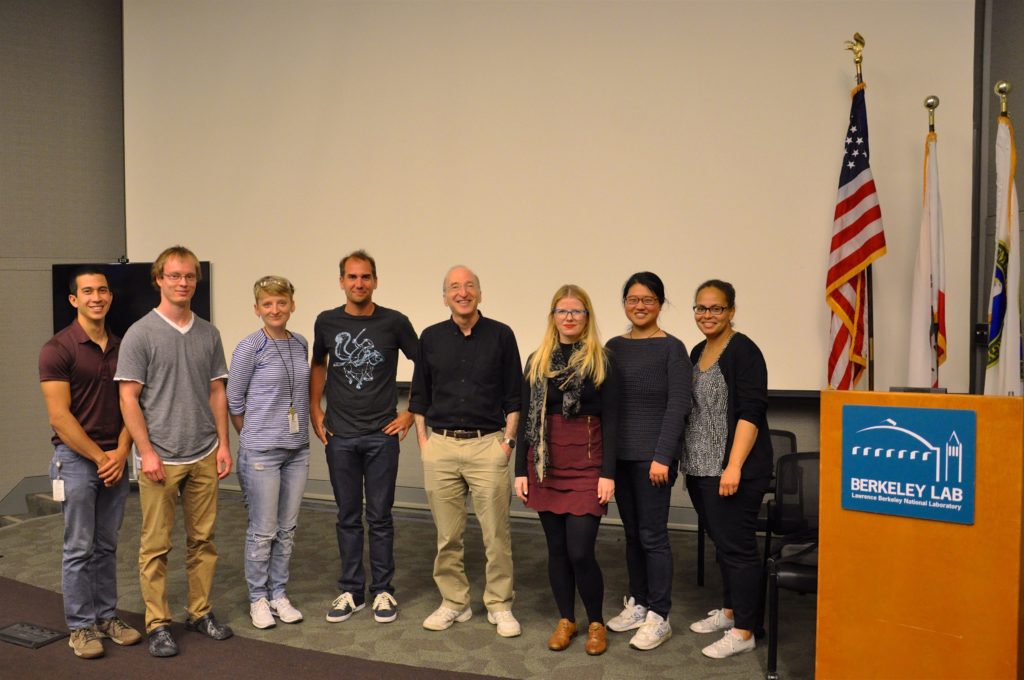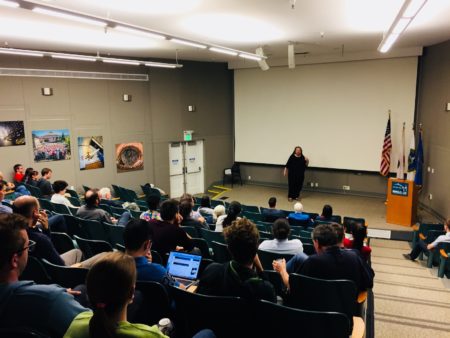Broadening horizons—that’s the objective of “BLPA Seminars: Series-X”. We invite speakers who are established scientists and thinkers to share their professional and personal experience with postdocs. Typically every last Monday of a month from noon to 1 pm, we host a new seminar in the Auditorium of building 50 with another inspiring speaker. After a “free-style” presentation, we devote the second half of each seminar to questions and answers and open discussions. Check out below for the upcoming and past seminars. contact: postdoc@lbl.gov

Upcoming events
Winter 2019 — Carolyn Bertozzi (date TBD)
Past seminars
January 11th, 2019 11am-12pm, building 50 Auditorium
Eva Nogales, scientist, LBNL; professor, UC Berkeley; member, National Academy of Science
Dr. Nogales is a Senior Faculty Scientist at the Lawrence Berkeley National Laboratory working on Cryo-EM to determine high resolution structure of proteins. She is member of the National Academy of Science and a staunch advocate for postdocs. She is also a Howard Hughes Medical Institute investigator and professor of Biochemistry and Molecular Biology at the UC Berkeley. (twitter thread)
November 2nd, 2018 11am-12pm, building 50 Auditorium
Félicie Albert; Scientist, Lawrence Livermore National Laboratory
“From Chirped Pulse Amplification to laser-plasma accelerators: the legacy of the 2018 Nobel prize.”
The 2018 Nobel prize in physics was awarded to Donna Strickland and Gérard Mourou for the invention of Chirped Pulse Amplification (CPA). Since its first demonstration in 1985, CPA has enabled ultrashort laser pulses to be amplified to Petawatt-class peak powers, as well as many discoveries and applications. This seminar will discuss the history and current status of such lasers, and present notable applications, especially in the field of laser-plasma accelerators.
July 20th, 2018, 2018 11-12pm, building 50 Auditorium
Jaron Lanier, VR pioneer; author: Dawn of the New Everything; musician
Jaron Lanier is a pioneer of Virtual Reality, an author (“Who Owns the Future”, “The Dawn of the New Everything”) and a musician who had a key role in the Silicon Valley, interacting with luminaries such as Richard Feynman, Steve Jobs and Timothy Leary. He is Interdisciplinary Scientist at Microsoft Research. His writings, at the intersection of science, culture and humanities, offer a sober view of where technology is leading the world.
His books: Dawn of the New Everything, Who Owns the Future, You are not a gadget

Some interview pieces:
Soothsayer in the Hills Sees Silicon Valley’s Sinister Side – NYTimes
Jaron Lanier: ‘The solution is to double down on being human’ – The Guardian
You will love this conversation with Jaron Lanier, but I can’t describe it – Ezra Klein (Vox)
One Has This Feeling of Having Contributed to Something That’s Gone Very Wrong – New York Magazine
April 27th, 2018 11-12pm, building 50 Auditorium
Don DePaolo, Associate Laboratory Director for Energy and Environmental Sciences, LBNL
Donald DePaolo is the Professor of Geochemistry in the Department of Earth and Planetary Science at the University of California, Berkeley, with a joint appointment in the Energy Geosciences Division at Berkeley Lab. He established and directs the Center for Isotope Geochemistry, a joint research facility between Berkeley Lab and UC Berkeley. He has won numerous awards in the field of geosciences, including the Harry H. Hess Medal and the Urey Medal.
May 22nd, 2017 11-12pm, building 50 Auditorium
Robert Birgeneau, physicist, Chancellor emeritus at UC Berkeley
Robert Birgeneau is the former Chancellor of UC Berkeley and faculty in the Physics department.
From very modest upbringing, he earned his PhD from Yale University and started his career working at Bell Labs, where half of his colleague would go on to become Nobel Prize laureates. From there, he went to MIT, where he became the Dean of Science. Later on, he became the president of the University of Toronto, before coming to Berkeley as the Chancellor.
April 17th, 2017 11-12pm, building 50 Auditorium
Alexis Madrigal, Editor-at-large at Fusion.net, former senior editor at The Atlantic and Wired; author : “Powering the Dream“; founder 5it newsletter, Real Future and Containers podcast (iTunes)
Usually, for Series x, we like to talk about things past and we invite renowned scientists to talk about their journey in science. But this time, we will a have different kind of scientist, a journalist : Alexis Madrigal. He’s been editor at the Wired, The Atlantic and more recently at Fusion, where he led investigation at the border of technology and culture, but the broad definition of culture, trying to understand how communities (of gender, color) were affected. The most glaring illustration of this is the latest podcast series “Containers”, which I really invite to you listen, where the impact of global trade is dissected looking at the port of Oakland.Thought the methods and means might be slightly different, scientist and journalist share a common goal: investigate a topic and reporting their finding. Madrigal’s former colleague Ta-Nehisi Coates that he came to journalism because it is a tool for seekers it’s a similar sentiment that brings researchers to science. But sometimes, truth-seekers are under assault; techniques applied to climate-change whistleblower (just a theory, biased, and so on) are now applied to mainstream journals that are now called fake-news (in a strange reversal of the term, that is). Madrigal was a visiting scholar at Berkeley, and wrote a book talking about the past history of renewable energies, where we learn that changes in administration are not new, and there might be some lessons to learn from previous shifts.
Cancelled
Fort Felker, Director at Makani (Alphabet’s [x]), former director at NREL
February 27, 2017, 11-12pm, building 50 Auditorium
Marjorie Shapiro, Department of physics at University of California, Berkeley
pictures of the event
Marjorie Shapiro in an experimental particle physicist whose interests lie in probing the most basic interactions in nature. There now exists a theory of the Strong and Electroweak interactions (“the Standard Model”) that has been tested to high accuracy and that explains almost all existing experimental data. She is a member of the ATLAS collaboration at the CERN Large Hadron Collider (LHC). Her research on ATLAS spans many topics including searches for TeV scale gravity and for Supersymmetry, searches for flavor violation in Higgs Boson decays, measurements of the production properties of the Top quark, studies of charm production in association with W-bosons and measurements of the properties of high pT jets.
She has been the Chair of the Physics department at UC Berkeley, and her research on the Higgs Boson is closely related to the Nobel Prize in Physics awarded in 2013 to Peter Higgs and François Englert.
February 14, 2017, 11-12pm, building 50 Auditorium
Nicola Spaldin, Chair of Materials Theory at ETH Zurich
pictures of the event
Nicola Spaldin is the chair of Materials Theory at ETH Zurich, and the 2015 winner of the Korber European Science Prize for “laying the theoretical foundation for the new family of multiferroic materials”. Having earned her bachelor’s degree in Natural Sciences at the University of Cambridge, she received her PhD in Chemistry at UC Berkeley. Spaldin’s search for mutliferroic materials commenced after a remark made by a colleague studying magnetic materials during her postdoc stay at Yale University. Prof. Spaldin was a professor at UC Santa Barbara, where she also directed the International Center for Materials Research, until her move to ETH Zurich in 2010. Spaldin is a fellow of the American Physics Society and the American Association for the Advancement of Science, the 2010 Winner of the APS James C. Mc Groddy Prize, and a 2017 L’Oreal-UNESCO Women in Science laureate.
–winter break–
November 28, 2016, 12:15 – 1 pm, building 50, Auditorium
Paul Alivisatos, Vice-Chancellor of Research at University of California, Berkeley
Paul Alivisatos has had a very successful scientific career, focused on material sciences and everything related to quantum dots. He was previously the director of Lawrence Berkeley National Lab, succeeding in that function to Steven Chu, Nobel Prize laureate who left to lab to serve as Secretary of Energy. He is the founder of Nano Letter, a very influential journal, and he is responsible for spinning off number of companies that now make the quantum dots now present in the best phone screens and TVs. (corresponding blog post)
November 7, 2016, 12-1 pm, building 50, Auditorium
Mina Bissell, Bissell Lab, Lawrence Berkeley National Laboratory
Mina Bissell has been recognized for her lifetime contributions to the fields of breast cancer research, the enhanced role of extracellular matrix (ECM) and the nucleus environment to gene expression in normal and malignant tissues (TED talk). These works have ushered and have changed some central paradigms that have strengthened the importance of context in the development of cancer (corresponding blog post)
October 31, 2016, 12-1 pm , building 50, Auditorium
Frances Hellman (Dean of Physical Sciences at University of California, Berkeley)
She has been on a large number of national and local science boards, including the NSF Advisory Board on Math and Physical Sciences, the NRC Board on Physics and Astronomy, the NRC Solid State Sciences Committee, the DOE Division of Materials Science and Engineering Council, ICAM (Institute for Complex Adaptive Matter), the APS Committee on the Status of Women in Physics, the APS Panel on Public Policy and many others.
August 29, 2016, 11 am – 12 pm, building 50, Auditorium
Prof. Dr. Saul Perlmutter, UC Berkeley, LBNL – Nobel laureate
Saul Perlmutter is the Franklin W. and Karen Weber Dabby Chair holder in the Physics Department. He graduated from Harvard magna cum laude in 1981, received his PhD from UC Berkeley in 1986. He joined the UC Berkeley Physics Department in 2004. He is also an astrophysicist at Lawrence Berkeley National Laboratory and leader of the international Supernova Cosmology Project, which first announced the results indicating that the universe will last forever, with its expansion ever accelerating. In 1996, he received the American Astronomical Society’s Henri Chretien Award. Perlmutter has also written popular articles for Sky and Telescope magazine and has appeared in recent Public Broadcasting System and BBC documentaries on astronomy and cosmology. Professor Perlmutter, who led one of two teams that simultaneously discovered the accelerating expansion of the universe, was awarded the 2011 Nobel Prize in Physics, which he shares with two members of the rival team. (corresponding blog post)
June 15, 2016, 12 pm – 1 pm, building 50, Auditorium
Dr. Michael Witherell, Director LBNL
Dr. Michael Witherell is our current Lab Director, and he is a leading physicist with a highly distinguished career in teaching, research and managing complex organizations. He previously served as Vice Chancellor for Research for University of California, Santa Barbara from 2005-2014, during which time he was also the Presidential Chair in the Physics Department. From 1999-2005, he served as Director of Fermi National Accelerator Laboratory (Fermilab), the largest particle physics laboratory in the country. From 1981 to 1999, Dr. Witherell was a faculty member in the UCSB physics department. He is the recipient of the American Physical Society’s W. K. H. Panofsky Prize in Experimental Particle Physics. Dr. Witherell received his Ph.D. from the University of Wisconsin, Madison, in 1973 and his B.S. from the University of Michigan, Ann Arbor, in 1968. (corresponding blog post)
